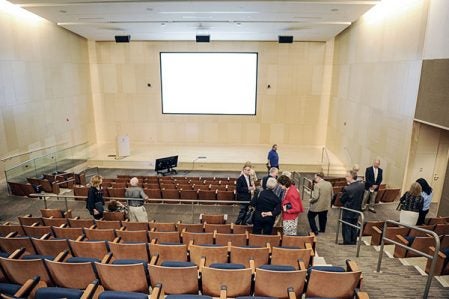The top stories from 2016: Hy-Vee development tops the Herald’s stories of year, based on your votes
Published 12:01 pm Sunday, January 1, 2017

- Outgoing Hy-Vee store manager Todd Hepler takes cell phone video as an excavator tears into the main Oak Park Mall entrance early this year. Herald file photo
Editor’s note: Stories 11-20 appeared in Friday’s Herald.
1. Hy-Vee takes down mall, starts work on new store
(46 percent)
Construction of the new Hy-Vee store, scheduled to open this spring, easily took the vote for the top stories of 2016.
And, no wonder. The project, whose planning began in 2014, resulted in the Oak Park Mall being demolished and a new, 60- to 90,000-square foot complex being built.
All indicators are that the new store, located west of the current site on 18th Avenue Northwest, will be open and ready for business by summer.
Hy-Vee acquired the mall in November 2015 with help from the city of Austin, the Austin Port Authority and a $3.65 million grant from The Hormel Foundation. Demolition of the site began in March 2016.
All but Younkers, Cinemagic 7, Anytime Fitness and Shopko were demolished in order to make way for the new store.
The store is expected to have the best of everything Hy-Vee has to offer. In late 2016, Mayo Clinic Health System reported it would install a new quick care clinic within the Hy-Vee store.

Food Network personality and chef Sunny Anderson takes a selfie with Meriam Luehmann during the Hormel 125th anniversary celebration.
2. Spamboree: New beginnings for Hormel in 2016
(27 percent)
It was a year of new beginnings at Hormel Foods Corp. in 2016 — and a year of celebrating the past.
The Austin company marked its 125th year of operation with a major community party featuring The Band Perry last summer, that happily coincided with the recent opening of its new Spam museum in April. The new museum, located at 101 Third Ave. NE, hosts all things Spam, from interactive and history displays, to touch-screen recipes, kids play area and exhibits of Spam around the world.
There were also new beginnings in the company’s leadership. James Snee, president of the company, took over the CEO reins from retiring CEO Jeffrey Ettinger (see separate story).
Perhaps the best part of the year, however, was the record performance for the fourth quarter, and for the year.
Officials reported net earnings of $244 million for the fourth quarter, up 30 percent from 2015. The company also reported record dollar sales of $2.6 billion, a 9 percent increase.
3. New president, new local faces
(16 percent)
The election of Donald Trump for president elicited strong response from both voters and pollsters in 2016. A few days after the general election, the Austin Daily Herald asked readers about their reaction to a Trump administration. Opinions fell strongly on two sides: 49 percent said they were excited to see how a Trump presidency would fare, while 37 percent said they were “fearful for the future.” Only 8 percent of the 1,222 voters said they were undecided, while another 6 percent said the election made no difference to them.
The election also changed the landscape of both the Austin City Council and the Austin School Board.
Laura Helle and Paul Fischer unseated council incumbents Michael Jordal and Jeremy Carolan in the election. Carolyn Dube is the new face on the School Board, replacing Mary Lou Kestner, who chose not to run for re-election.
Tim Gabrielson and Polly Glynn were both re-elected to seats on the Mower County Board of Commissioners.

Visitors check out the Ray Live Learning Center during the grand opening for The Hormel Institute’s expansion celebration. Herald file photo
4. The Hormel Institute expands
(13 percent)
The Hormel Institute unveiled its 20-lab expansion in June 2016, also showcasing its $4.5 million Ray Live Learning Center, a global communications area on the west side of the institute, designed to enhance Institute scientists’ ability to collaborate worldwide.
The space was named after a major donation given by Gary and Pat Ray.
The 250-seat auditorium provides state-of-the-art communications technology and a large multipurpose center outside the theater.
The Center was funded through $1.5 million gifts made by both The Hormel Foundation and University of Minnesota and another $1.7 million raised from the community. Donations came from individuals, businesses and organizations and exceeded the $1.5 million “Coming Together for the Cure” campaign goal by about $200,000.
The Institute also unveiled the $4.3 million cryo-electron microscope, one of the most advanced used in research today, that will help scientists analyze the structure of proteins and amino acids.
5. New recreation center coming
(11 percent)
The Austin City Council in October approved an amended lease agreement for the $35 million Austin Community Recreation Center to be built at the downtown Austin Municipal Plant.
The rec center will be built at the plant site and based around a new YMCA, which will feature an aquatic center, gyms, a gymnastics facility, workout rooms and a running track along with public spaces like an indoor playground, a Youth Activity Center and meeting rooms.
The rec center is expected to cost $35 million to build with $25 million pledged by The Hormel Foundation, $5 million from Hormel Foods Corp. and another $5 million is to be raised through a community campaign.
Discussion of the design, programming and fundraising for the future facility are under way.
6. Deputy Brady Muelken passes away
(9 percent of the vote)
Deputy Brady Muelken’s passing on Oct. 14, 2016, left heavy hearts across Mower County and his native Prior Lake.
Muelken had been with Mower County Sheriff’s Office for six years when he died of natural causes.
Muelken grew up in Prior Lake and graduated from Prior Lake High School in 2003.
He attended the University of Minnesota, Duluth where he studied economics and business before going back to school at Rochester Community and Technical College to complete a law enforcement degree. He first moved to Austin and worked as a correctional officer at the Mower County Jail before he eventually joined the Mower County Sheriff’s Office.
“It was clear that Brady had it in his DNA,” his obituary read. “He was born to serve and protect.”
7. Ettinger retires from Hormel
(8 percent of the vote)
A few months after celebrating 125 years as a company, Hormel Foods Corp. experienced a big changing of the guard.
Jeffrey Ettinger retired in late October as CEO and was replaced by President James Snee. Ettinger remains chairman of the board.
“It’s been a pretty good run,” Ettinger said in October.
Ettinger, a California native with a law degree, came to Hormel in 1989; by 1999, after turns as senior attorney and project manager for Hormel chili products, he was named president of the Jennie-O Turkey Store, the largest subsidiary of the company, based in Willmar.
Five years later, Ettinger was named president of Hormel, a position he held until Snee took the post in 2015.
Ettinger admitted to “mixed feelings” about leaving, but he said it was “the right time and Jim is going to do a fantastic job” in his new role. Ettinger and his wife, LeeAnn, have four children; three live in Minneapolis and another in California.
In July leading up to Hormel’s anniversary, Ettinger noted how it had been an exciting era to watch the company’s growth, going from about $2.8 billion in sales in 1991 to about $5 billion in shares a decade ago when Ettinger became CEO to about $9.3 billion in 2015.
Under Ettinger’s leadership, Hormel Foods grew through acquisitions, organic growth and a continued focus on new product innovation.
Snee, a native of New Mexico, earned degrees in business and marketing before coming to Hormel in 1989. He was named director of purchasing in 2006 and president of affiliated business units in 2008. In 2011, he earned the title of vice president and senior vice president of Hormel Foods International and a year later was named to group vice president of Hormel Foods and president of the international branch in 2012.
Snee said he was excited to continue the sales and product expansion progress made under Ettinger’s tenure.

Kelly Nesvold greets supporters after completing the 300M4FREEDOM this summer at Cornerstone Church. Herald file photo
8. Nesvold finishes grueling 300M4FREEDOM
(7 percent of the vote)
Weary and sore, Kelly Nesvold finished what could be his most harrowing journey yet on Aug. 28 when he crossed the finish line at Cornerstone Church to compete the 300M4FREEDOM triathlon.
The self-challenging race began at Pokegama Lake in Grand Rapids and ended on a humid and stuffy Sunday morning having raised about $40,000 to raise awareness about human trafficking.
In 2015, Nesvold ran 100 miles to raise money and buy 100,000 meals for children overseas. But in 2016, he upped the ante with a 300M4FREEDOM triathlon, which raised money to bring awareness to human trafficking. Nesvold, his wife, Danielle, and a friend, Eric Feuchtenberger, worked with Mission 21 in Rochester and other charities to create a statewide effort to educate and create awareness for human trafficking.
The triathlon included a 5-mile swim across Pokegama Lake in Grand Rapids, a 240-mile bike ride through the metro area, and a 55-mile run through Faribault and to Austin.
Many people helped the Nesvolds and Feuchtenberger in their push.
The Nesvolds’ daughter, Julie, who is attending I.J. Holton Intermediate School this year, ran a marathon distance with her father.
9. Austin Utilities moves to new central facility
(6 percent of the vote)
Austin Utilities completed a major upgrade to its facilities in 2016.
In October, it showed off the inner workings its new $17.5 million Austin Utilities Service and Operations Center in Energy Park at 1908 14th St. NE.
The center consolidated Austin Utilities services and operations to one site, and General Manager Mark Nibaur said his favorite part of the facility is that it flows well and is efficient for Austin Utilities’ 79 full time and 7 part-time employees.
“[It’s] a great achievement for our staff,” Nibaur said.
Austin Utilities’ need for a new facility was significant, as Nibaur said it needed a building to consolidate office operations, including customer service, staff operations and administrative duties, from the former seven buildings utilities workers used to one central site.
Two of Austin Utilities’ old sites are now set for new life too: The former downtown Austin Utilities Plant will become the site for the Austin Community Recreation Center, and the city of Austin is remodeling the former Austin Utilities space in City Hall into office space.
The neon lights on the Austin Municipal Plant will shine on, as they were set to move to the 14th Street Northeast facility.
10. Austin native, author makes Time’s most influential list
(6 percent of the vote)
Austin native Ann Hope Jahren received a warm welcome when she returned home over the summer and help reception at Austin Public Library.
She chatted with fans and community members, signed books, and read a few passages from the book, including one about her childhood in Austin.
“I learned how to value Austin,” she told the crowd before reading a few passages.
It was one highlight in a big year for the author and scientist.
Jahren published “Lab Girl,” which features her childhood in Austin growing up the daughter of an Austin Community College professor to her life as a scientist and her work with her friend, Bill.
The book reached the New York Times Best Seller List, and Jahren was named one of Time Magazine’s 100 Most Influential People.
After working as a professor at the University of Hawaii Manoa, she and her family moved to Norway, where she took a job at the University of Oslo.




